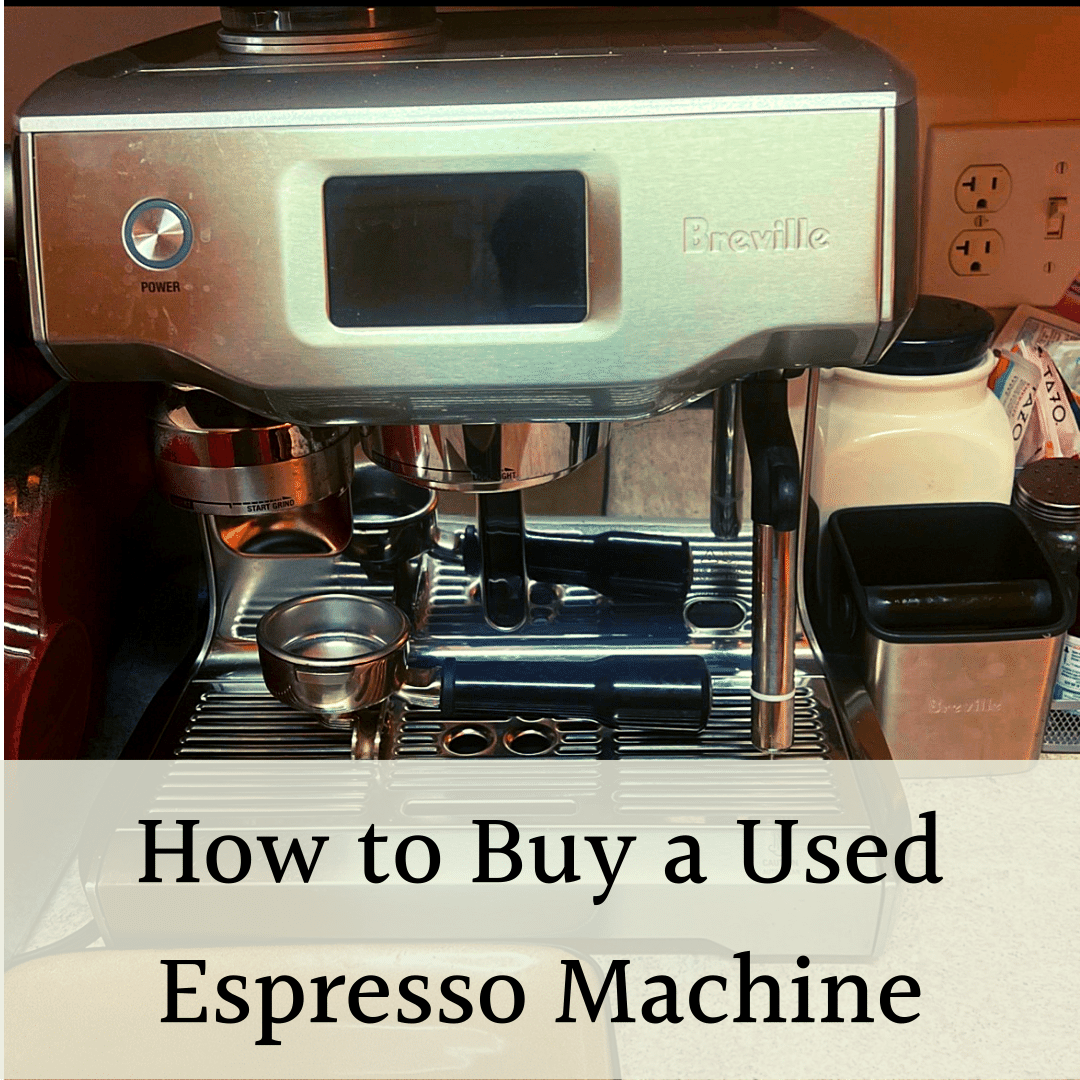A manual espresso maker gives you complete control over the brewing process and allows you to enjoy a perfect shot as long as you’re willing to invest time and effort. The reward is huge for any true espresso lover — an espresso shot that’s a perfect blend of sweetness and acidity, topped with thick crema.
I tested several manual espresso machines to find the ones that produce the highest quality coffee. My top picks are Flair 58 and La Pavoni EuroPiccola, with Rok Presso Manual a great budget choice.
Here’s a round-up of the six best manual espresso machines, including individual ease-of-use ratings, plus a guide on what to consider before choosing the best manual espresso maker.
Understanding Manual Espresso Machine
A manual espresso machine is a lever or hand-pumped device that makes espresso shots. These are minimal devices that require a lot of work on your part. You have to heat water in a kettle and pour it into a vessel above the coffee grounds. Then you need to raise a lever to get water into the brewing chamber so the ground coffee is saturated (also called pre-infusion). You depress the lever to create pressure which forces water through the coffee grounds and, finally, into your cup.
Manual espresso machines can make excellent coffee and are lower-cost alternatives to electric machines with integrated boilers and pumps. The main advantage of a manual machine is control over the pressure. If you keep getting sour shots with your espresso machine, it might not be you; many semi-automatic models are set to 12-15 bars of pressure, which you can’t change (easily, at least). With a manual machine, you can generate steady pressure, leading to a full-flavored shot every time.

On the downside, manual machines have more maintenance. They need to be disassembled and reassembled each time you pull a shot. They tend to have small portafilters that pull a tiny espresso at a time.
Dialing in is the crucial part of using a manual espresso machine. You need to dial in correctly to get good extraction.
Overall, a manual espresso machine requires a learning curve to pull good shots, but you have complete control over everything, including pressure. You can tweak your drink so it suits your taste perfectly.
Types of Manual Espresso Machines
There are two kinds of manual espresso machines: spring pistons and direct lever espresso machines.
The spring piston espresso machine has the lever in the upright position when not in use. You push the lever down to cock the spring mechanism. When you release the lever handle, the spring slowly comes back up, which pushes the water through the coffee in the portafilter.
You control the pre-infusion, how much water you want over the grounds, and when to pull the shot. These machines are convenient, and it’s easy to always create consistent pressure for every shot.
The direct lever espresso machine has a lower lever position when not in use. You put pressure on the lever, which in turn puts pressure on the water as it extracts the espresso. More work and practice are required to master using this espresso machine successfully. It’s more difficult to recreate the pressure consistently. However, you also have complete control over the pressure, speed, and volume.
Individual Reviews: Best Manual Espresso Machine
Each review includes an ease-of-use rating to measure how hard it is to pull the perfect shot. The rating goes from 1 = hard to 5 = easy.
| Image | Product Name | Features | Price |
|---|---|---|---|
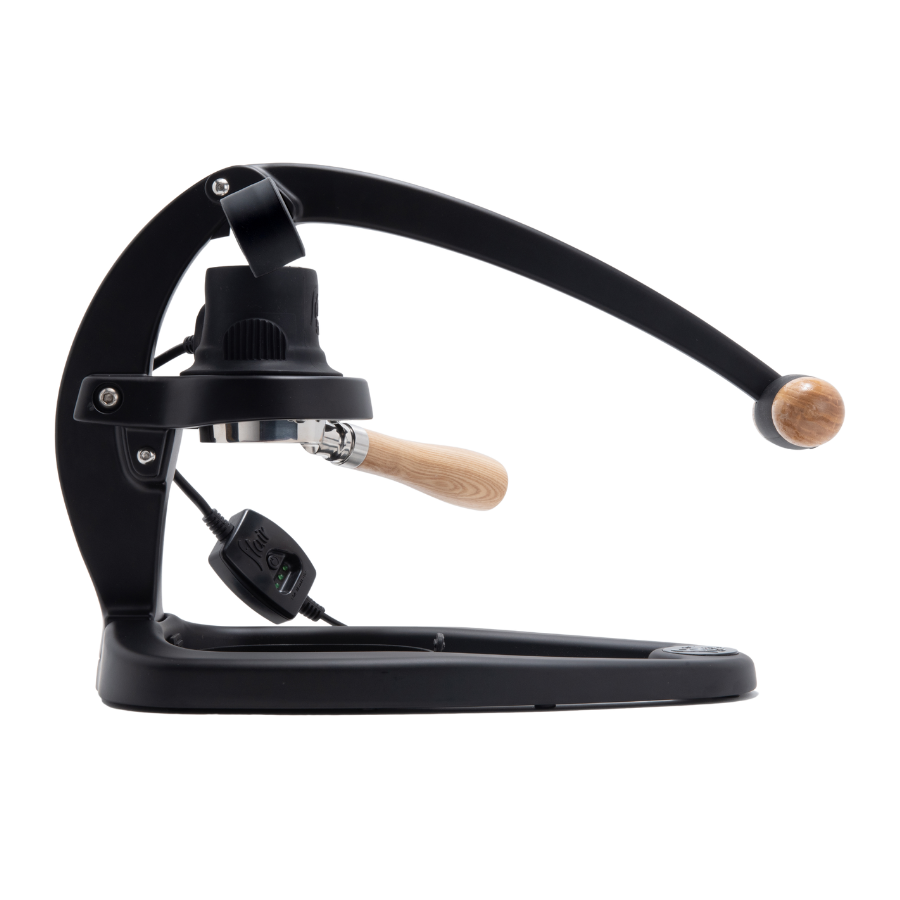 |
| Check Prima Coffee | |
 |
| Check AmazonCheck First In Coffee | |
 |
| Check Amazon | |
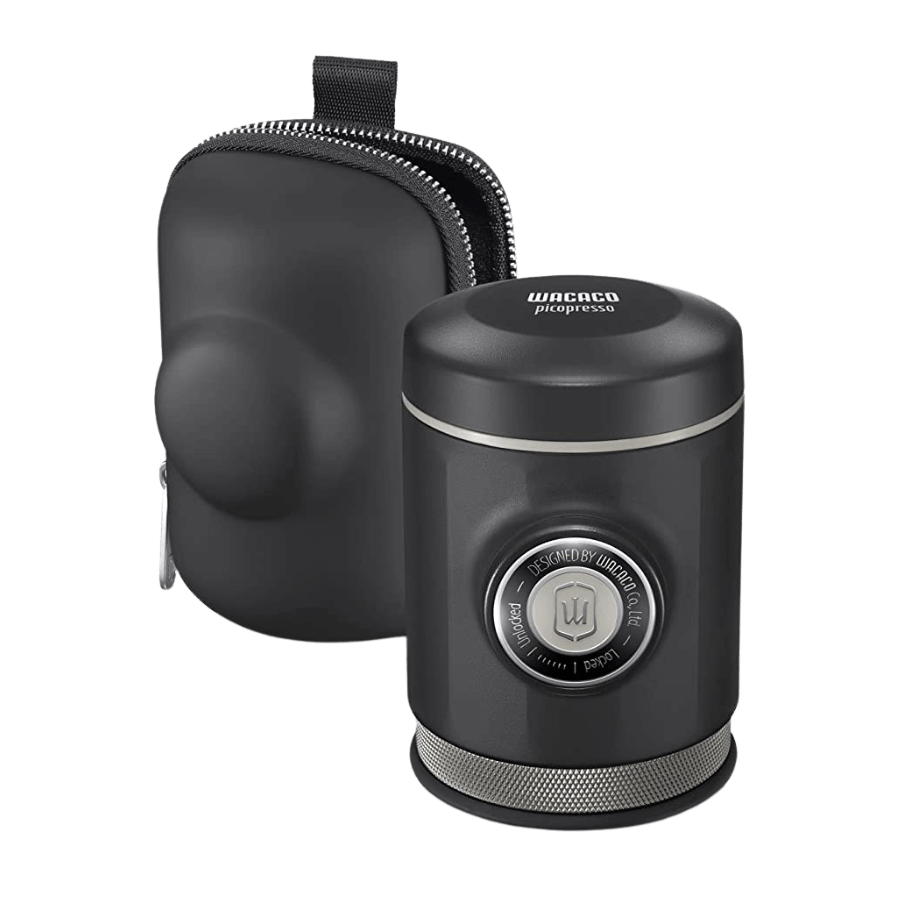 |
| Check Amazon | |
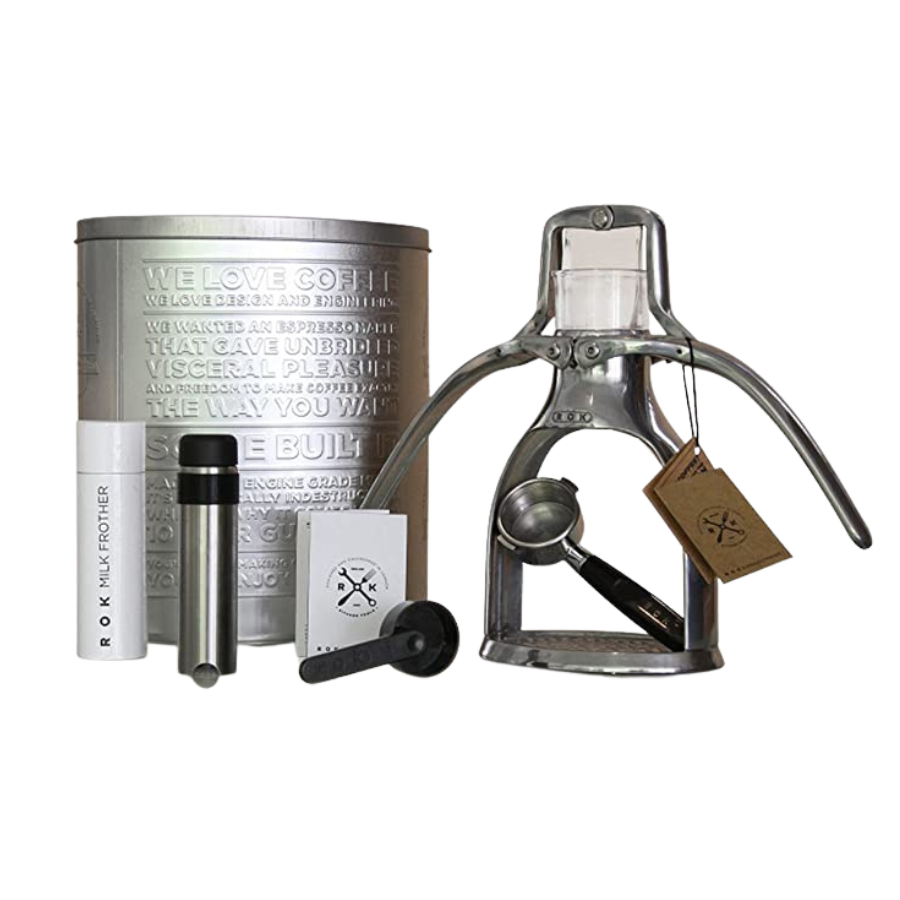 |
| Check Amazon | |
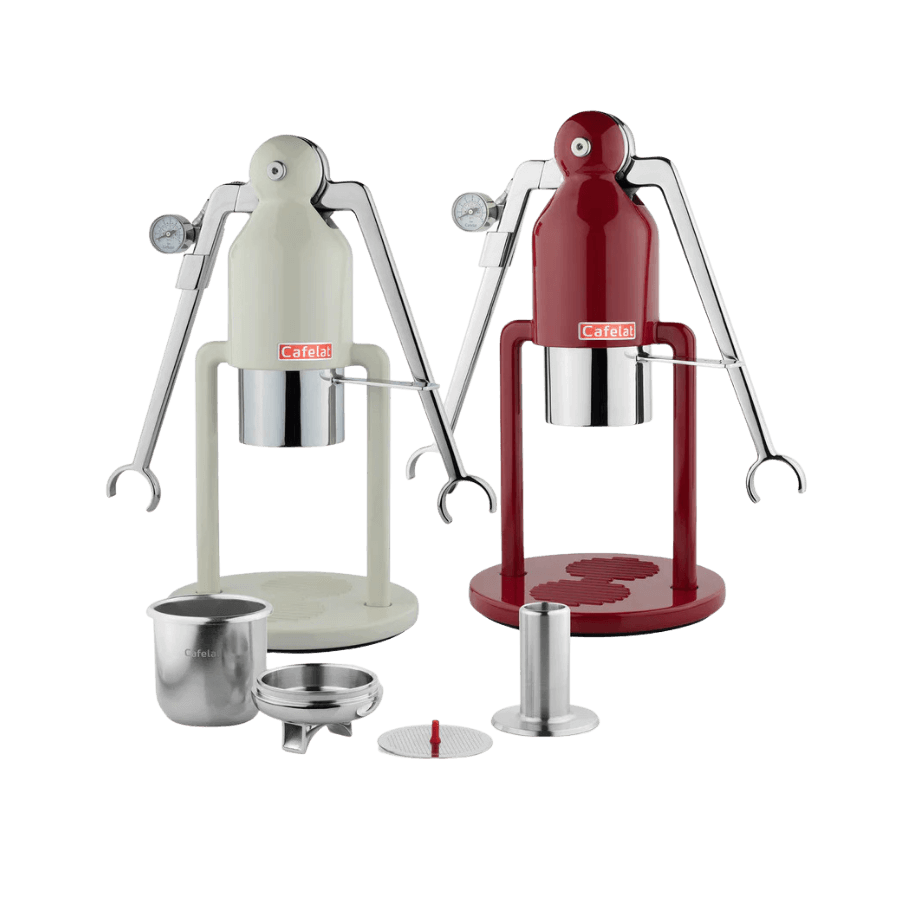 |
| Check Cafelat Store |
1. Flair 58

Flair 58 specs:
- Ease of Use: 5 (too easy)
- Pressure generated: 9 bars
- Dimensions: 20 × 14 × 6 in
Flair 58 is a stunning manual espresso maker with an electronic temperature control system. In other words, this is one of the rare manual espresso makers that need electricity to run. Technically, it’s not fully manual, but the upside is the espresso machine preheats the brewing chamber, so you don’t need to do it yourself. This guarantees optimal thermal control and a speedier brewing process.
Keep in mind Flair 58 only heats the brewing head (not the water). There are three temperature levels: 185 degrees (low), 194 (medium), and 203 (high).
Flair 58 has a professional grade 58 mm portafilter with a wooden handle. The commercial-size portafilter lets you use accessories such as a tamper and precision filter baskets. The manufacturer includes a bottomless, naked portafilter that makes monitoring the shot during the extraction easy. It’s interchangeable with other espresso machines, so just about anyone can use it.
Flair 58 also has a pressure gauge, so you can keep an eye on the pressure when pulling a shot. However, once you get the hang of the pressure to apply to reach 9 bars, you’ll stop paying attention to the pressure gauge. Still, it’s useful in the beginning, and it’s nice Flair included it with this model.
Overall, this manual espresso machine has a modern, sleek design, a durable build, and an easy-to-use lever (it’s easy to modulate the brewing pressure when pulling a shot). It’s a good choice if you have a budget, wants to pull large shots, and if you want a machine that’s easy to use.
Pros
Well-built with metal parts, a wooden handle, and a thermal jacket for the piston
Easy assembly
Pre-heats the brewing chamber
Comes with a 58 mm portafilter
Cons
Needs electricity to run
More expensive than other manual machines
2. La Pavoni EuroPiccola

La Pavoni EuroPiccola specs:
- Ease of Use: 2.5 (medium)
- Pressure generated: 9 bars
- Dimensions: 11 x 7 x 12 in
La Pavoni EuroPiccola has a classic design that resembles semi-automatic espresso machines. That’s because it’s a full-blown espresso machine that has a steam wand and a 0.8l boiler. You can brew 8 cups of espresso with this manual espresso maker.
It even has a steam wand that makes thick and rich foam for cappuccinos.
EuroPiccola is a direct lever espresso machine, so it takes practice to learn when and how much pressure you should apply. It doesn’t help that there’s no pressure gauge, so you need to buy one separately. However, it does have a water level gauge and a safety valve. EuroPiccola also has internal thermostats that monitor the pressure for the best flavor.
Although EuroPiccola has some plastic parts, it has a triple-plated chrome base, stainless steel heating elements, and brass boilers, so it’ll last for years to come. It comes with a tamper, a screen, and a measuring scoop, so all the accessories you need are already included.
EuroPiccola lever espresso machine is an excellent choice if you want a machine that’ll last for years and gives you total control over the brewing process. It’s also a good option if you aren’t afraid of a steep learning curve.
Pros
Has a built-in steam wand
Heats quickly
Easy to customize drinks
Cons
No pressure gauge
Very expensive
Steel learning curve
3. Flair Pro 2

Flair Pro 2 specs:
- Ease of Use: 3.8 (easy, except disassembly)
- Pressure generated: 9 bars
- Dimensions: 14 × 10 × 4 in
Flair Pro 2 is a budget-friendly machine that’s easy to master. It has a 46 mm portafilter and a 70 ml reservoir. I have to mention the build quality. The portafilter, tamer, and dispersion screen are made of stainless steel, which makes them durable. The handle has a silicone grip which makes use easier.
This Flair manual espresso maker has a built-in pressure gauge, which you’ll find especially useful in the beginning until you develop muscle memory for the right amount of pressure to apply.
This manual espresso machine also has a bottomless portafilter, so you can see every part of the extraction process. Moreover, while the portafilter isn’t as large as the one on the Flair 58, it is larger than other Flair manual espresso machines. It can hold 24 g of ground coffee and yield 56 ml of espresso. It has enough capacity to approach a double shot, which is great if you like a stronger caffeine kick.
The disassembly is annoying, as you need to detach the hot brew head from the cylinder, which is uncomfortable on your fingers. You also have to preheat the cylinder in a bowl, which adds another step.
Overall, Flair Pro 2 is a great choice if you want a manual espresso machine that doesn’t cost an arm and a leg, has a built-in pressure gauge, produces quality espresso, and isn’t too difficult to learn how to use.
Pros
Comes with a travel bag
Yields up to 56 ml of espresso
Detachable brew head for easy cleaning
Cons
You need to preheat the brew head
4. Wacaco PicoPresso

Wacaco PicoPresso specs:
- Ease of Use: 3.5 (medium)
- Pressure generated: 18 bars
- Dimensions: 4.1 x 3 x 2.8 in
Wacaco PicoPresso weighs only 350 g, so it’s the best portable manual espresso machine you can get. It comes with a cleaning brush, steel tamper, scoop cup, distribution tool, and rubber caps.
PicoPresso can brew a double espresso shot. This manual espresso maker has a hand pump that can produce up to 18 bars of pressure (which is comparable to more expensive automatic espresso machines).
You add 20 g of ground coffee to the 52 mm stainless steel basket. The machine comes with a distribution tool you use to even out the grind. Then tamp with the steel tamper stored at the bottom of the water chamber lid.
The water chamber holds 90 ml. You should add boiling water to preheat the unit. I found the pumping somewhat more difficult than on the other manual espresso machines. The mechanism is integrated into the center vessel, so you need to pump from the side, not the top.
PicoPresso manual espresso machine is a good choice if you want a unit with all the necessary accessories. It’s also a good option if you want to take it with you when on the go, as it’s light and cleans easily.
Pros
Accessories fit in the manual espresso machine
Commercial coffee basket
Can make a double shot
Lightweight
Cons
Accessories not dishwasher safe
Takes time to find the right grind
5. Rok Presso Manual

Rok Presso Manual specs:
- Ease of Use: 4.5 (easy, but minimal)
- Pressure generated: 5 to 10 bars
- Dimensions: 12.2 x 10.6 x 7.9 in
Rok Presso Manual espresso maker is all about functionality. It’s a basic espresso maker, so there’s no pressure gauge or any other accessories. You need to pay a lot of attention to the pressure you generate with the levers.
Rok Presso doesn’t need electricity to run, and it’s straightforward to use. It has a squat central column with a piston and water-loading chamber. You need to push down on the wing-style arms to build pressure, so it’s good that the four rubber legs on the base keep the espresso maker in place as you use it.
The brew head is located at the bottom. You load coffee similarly to a regular espresso machine by filling up the portafilter, tamping, and locking it into place. The portafilter and removable basket are on the smaller side at 40 mm.
There’s no boiler or pump, so you pour water into the top of the column, pull up the arms, and press them down to create pressure.
The Presso is a sturdy espresso maker (I wouldn’t call it a machine). It weighs less than 4 lbs and comes with a tin for storage, so it’s a good option for espresso-loving travelers.
Rok Presso is a great choice if you’re on a budget and want a manual espresso maker that’s easy to use and doesn’t require perfect technique. It has a metal design, so it’ll last for years, and you don’t have to worry about keeping it safe on the go.
Pros
Metal design
10-year warranty
Affordable
Cons
Plastic brew head
No pressure gauge
Only makes single shots
6. Cafelat Robot

Cafelat Robot specs:
- Ease of Use: 4 (easy)
- Pressure generated: 9 bars
- Dimensions: 12 x 19 x 10 in
Cafelat Robot, as the name says, resembles a robot. It’s another espresso maker, not a machine. Cafelat Robot has two pistons instead of one, so it’s easier to press down. There are two swing-out arms you need to push down on to drive the mechanical operation that makes coffee.
This espresso maker also comes with a pressure gauge installed, which makes use easier.
Its portafilter functions as a brew chamber, so there’s good thermal management. Plus, you don’t need to preheat two different parts.
The Robot won’t take up much space on your kitchen counter; it’s travel-friendly and not likely to break, thanks to the stainless steel build. The build material is die-cast aluminum for the body and stainless steel for other parts.
The Robot comes with a portafilter, professional basket, tamper, filter screen, filter paper, and a silicone mat. Overall, you’ll have all the accessories you need to brew espresso, plus a mat that keeps the espresso maker stable.
Cafelat Robot is a good choice if you want an eye-catching espresso machine that’ll give you years of faithful service. It’s also useful if you don’t want to worry about preheating, especially when using lighter roasts.
Pros
Comes with accessories, including a pressure gauge
Durable construction
Eye-catching retro design
Cons
Retro design not everyone’s cup of tea
Not easy to push levers down
Messy cleaning
What to Consider When Buying Manual Espresso Machines
Design and Build Quality
Ideally, manual espresso makers should have the best possible construction. This mostly means stainless steel, chrome, or bras. These materials are durable. Plastic tends to break, especially on manual machines, which you have to pump to get your coffee.
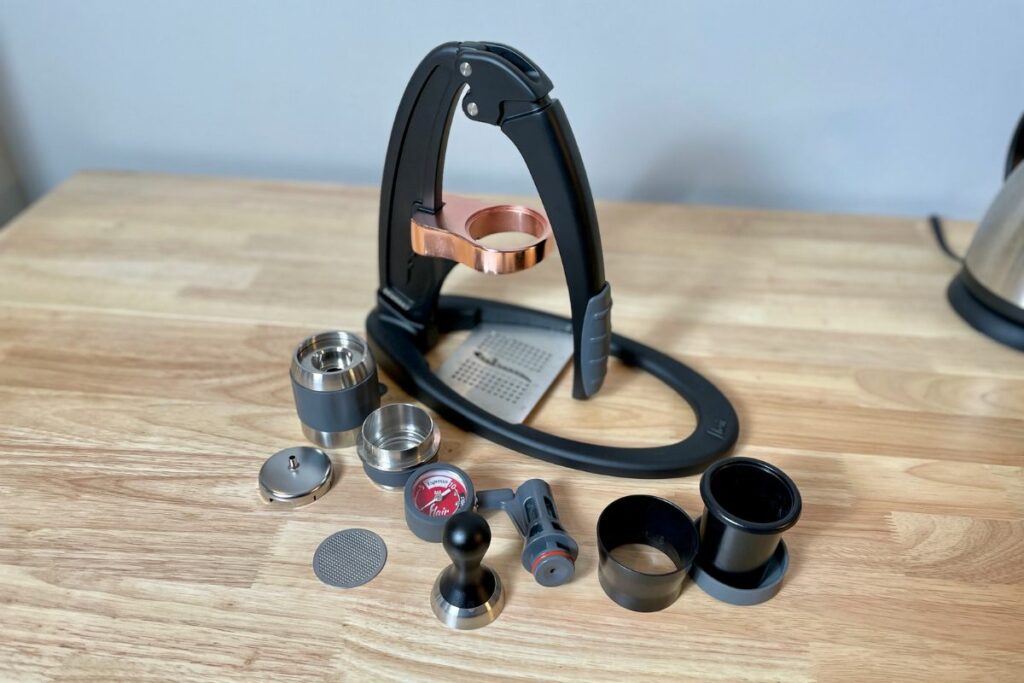
Overall, many lever espresso machines can last a lifetime if the build quality is good. There aren’t any or many electrical components that break down over time.
Ease of Use and Muscle Required
Manual espresso machines have a reputation for being difficult to use. I’m not saying this isn’t true. Far from it. But, some manual espresso machines are easier to use than others.
You need a deep knowledge of the brewing process and dialing in to produce a good shot. The learning curve is much steeper with a piston or a manual lever espresso machine than with an automatic one. But, the control is much greater as well, which means more chance of getting the espresso just how you like it.
You need to tamp the coffee grounds, adjust the settings, and know when to cut off the water flow. Most importantly, you have to create enough pressure, which leads us to the muscle strength needed to brew espresso. You need to manually pump or push a lever to produce pressure.

That being said, some manual machines are easier to use than others. For example, the machine’s design and lever responsiveness have a big impact on the ease of use. Rok Presso and Cafelat have swing-out arms, so you’ll need to use both arms to push them down and create pressure.
Others, such as Flair espresso makers, require pushing from the top, while PicoPresso needs to be pumped from the side. Think about what would work best for you and how much muscle strength you can provide. I included ease-of-use scores in the reviews to make your decision easier.
Espresso Quality
Espresso quality comes down to build quality. Best manual espresso machines can generate consistent pressure and water temperature when brewing espresso.
The espresso makers need to be able to generate nine bars of pressure for a full-bodied espresso topped with crema. But you’ll get bad results if the manual machine can’t produce consistent or strong enough pressure.
Generally, all espresso machines on this list can generate 9 bars of pressure, with PicoPresso going up to 18, which is on par with automatic espresso machines.
Budget
Manual machines cost from around $200 to over $1,000. The higher the price, the better the build quality, and the more accessories you get.
However, I don’t believe you need to spend thousand(s) of dollars to get a good espresso machine. Any coffee maker on this list would be a good choice, depending on how much you’re willing to spend. Flair 58 and La Pavoni EuroPiccola are among the most expensive options, with Rok Presso the most affordable, at just over $200.
Flair Pro 2 is a good in-between option. It’ll brew a delicious espresso without breaking the bank.
Overall, think about how many accessories you already have and check the build material to choose the best espresso maker for your budget.
What’s the Best Manual Espresso Machine for You?
You won’t make a mistake with any of the best manual espresso machines on this list. Think about your budget, expertise, and how much effort you’re willing to put into learning how to use an espresso maker.
If you want to see more options, we’re huge Flair lovers. Here’s our review of all the Flair espresso makers with their pros and cons.

